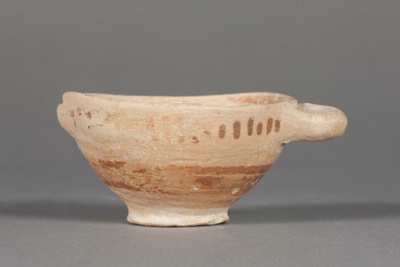< Collection search
< Collection highlights
From:UC Teece Museum of Classical Antiquities
Name/TitleKotyle
About this objectKotyle is a general term for a drinking cup, and is also used to describe a distinctive Corinthian type of deep cup with two horizontal handles, similar to a skyphos. It is the most common shape used for ordinary drinking cups for most of the Classical period in Corinth and Athens.
This cup imitates a Corinthian kotyle, but the style and type of clay used suggest it was made in Sicily or possibly Lucania (the southern arch of the boot of Italy). The pale brownish-buff clay has been covered with a slip and decoration has been added in orange-brown paint. In a seemingly simplistic geometric style, a series of vertical bars run between the handles, and there are two bands on the lower wall and foot. There is a band on the resting surface on the underside and the interior has been solidly painted. The surface is worn and one handle is missing. The lip is unevenly thrown, giving it a slight dip.
The kotyle (or cotyla) was also used as a unit of measurement by the Romans and Greeks from the 8th to the 6th centuries BCE onwards. Scholars have estimated the volume to be approximately equivalent to around half an Imperial pint or between 240-300 mls. Thucydides mentions cotylae of wine and also cotylae of bread, so it could be used as a dry measure as well as a liquid one.
Date Madeca. 6th Century BC
PeriodArchaic
Place MadeItaly
Place NotesLikely Sicilian, although could be from Lucania
Medium and MaterialsCeramic: Pottery
Style and IconographyArchaic
Style and IconographyGeometric patterns
TechniqueThrowing (pottery technique)
TechniqueRed-figure vase painting
MeasurementsHeight 38mm (maximum); Diameter 67mm
Subject and Association KeywordsRepetition (aesthetics)
Subject and Association KeywordsFood history
Named CollectionThe James Logie Memorial Collection, University of Canterbury, New Zealand
Object TypeDrinking Vessels
Object number203.07
Copyright LicenceAll rights reserved
